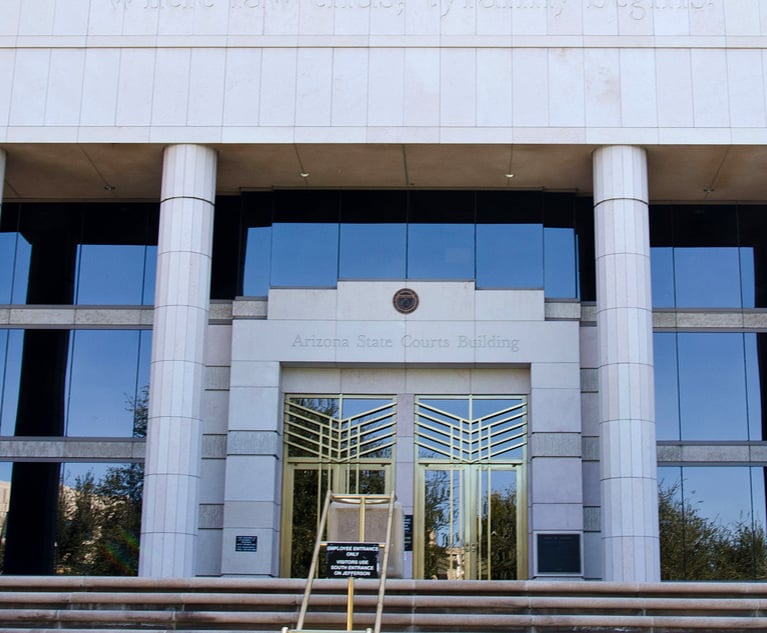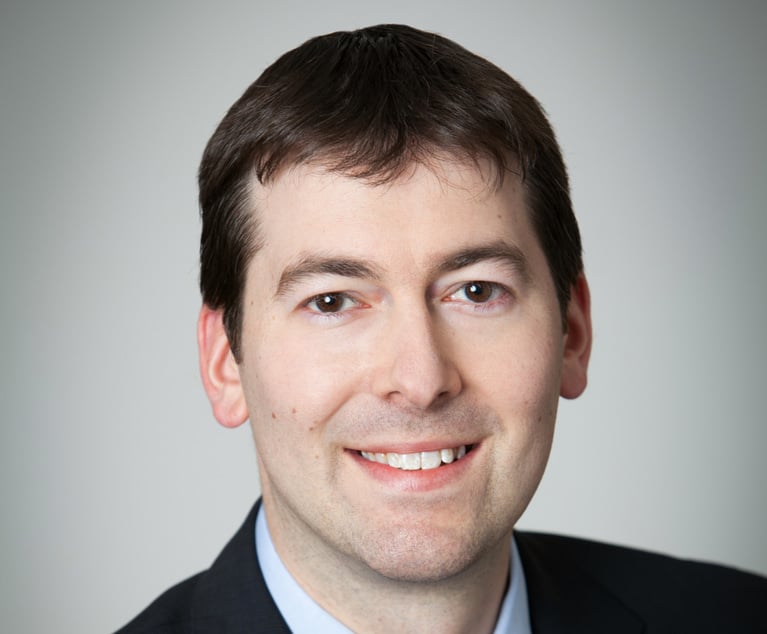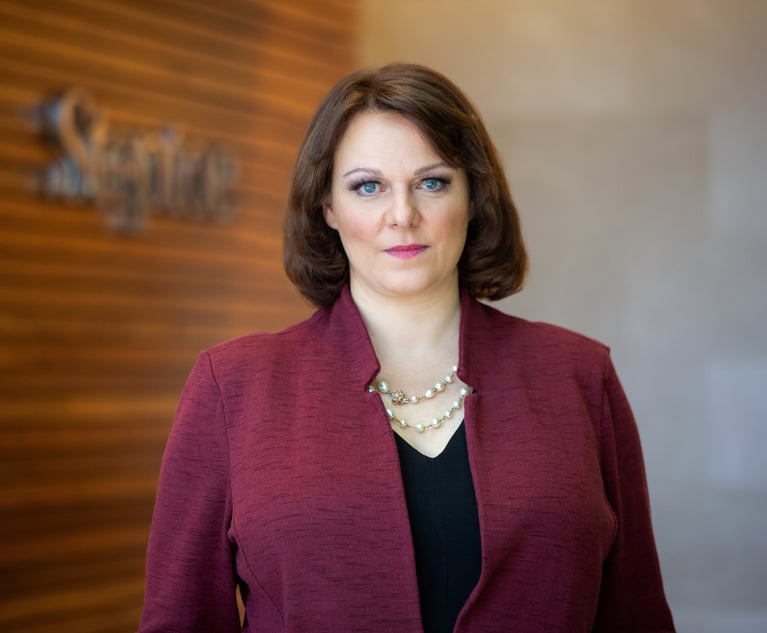Law Firms' Future Isn't About Rainmaking. It's About Change-Making.
Change-makers are quickly becoming a driving force in helping partners buy into new ways of thinking.
March 01, 2019 at 09:48 AM
8 minute read

Meet the rising star of new law: the change-maker.
Change-makers are lawyers with a relentless focus on growth who also recognize that long-term success requires more than revenue generation alone. With the head of a rainmaker and the heart of an innovator, change-makers are quickly becoming a driving force in helping partners buy into new ways of thinking.
Like rainmakers, change-makers are proven sellers with a high degree of visibility and influence across their firms. What differentiates them is the way they leverage their skills to promote growth through collaboration and innovation.
In doing so, they are helping firms calibrate for growth by promoting efforts to build balanced client portfolios, to attract and retain top talent, and to create more purposeful cultures centered on the client and partner experience.
Don't be mistaken—the change-maker is not a selfless Pollyanna out to change the status quo for the sake of making the world a better place. They simply understand the complexities around making change stick inside a firm where partners aren't just lawyers but are also sellers, account managers, owners, operators and investors.
As such, they see the importance of broadening the view of what it takes to sustain long-term growth in an environment where the only constant is change.
At their core, change-makers are growth ambassadors who support leadership by using their credibility to make the case for change and amplify leadership's call to action; ensuring innovation is focused on the client experience through collecting client feedback, inviting clients into the process and accelerating client engagement by participating actively with them in the process; and modeling positive behaviors around collaboration and effective teaming.
Change-makers' superpower is that they are master sellers. They recognize that the biggest thing holding their organizations back is the organization's own resistance to change. Change-makers understand how to sell the idea that change is in the firm's self-interest.
Just as a rainmaker knows that trying to persuade someone to buy when they aren't ready will never work, change-makers know that you can't make a partner do something unless the partner decides it's a good idea. Push too hard when someone isn't ready to buy in and you not only lose the individual, you create a “change-buster” whose negative ripple effect can cripple growth efforts.
Change-busters use their voice and influence to actively resist change, using three primary weapons:
- Time. Time is our most valuable and highly guarded asset. Its scarcity is universal, and it is hard to counter the defense that a person does not have enough time to participate in a growth initiative, particularly when the rewards are not immediate.
- Money. If time is a weapon of mass destruction, money is the equivalent of a high-impact missile. You've seen it at your firm in the form of a comment such as, “Sounds like a great idea, but it won't work with our current compensation structure.” The money weapon is particularly dangerous because it targets a firm's highest performers, who may perceive taking a chance on doing something different as a threat to their earnings, even when there is little or no evidence to prove the claim true.
- Fear. Fear is like a stealth bomb. It is usually unstated and often unconscious. Lawyers face relentless pressure for perfection. Fears of failure, rejection, looking bad, making a mistake and being ridiculed exist every day. Suggesting that lawyers add a change in process or outlook to their existing anxiety can feel threatening. It's important to identify this invisible factor in order to disarm it.
Change-makers are not only able to fight their own inner change-buster; they are able to combat these resisters. They don't manage change. They sell it. They leverage the same breadth of sales approaches they use for business development to sell partners on change, and they use a variety of profiles to do it.
The Educator
Many initiatives get stuck at the starting gate because of a failure to clearly define and communicate the what, why and the way to create change. Change-makers educate their partners by making the case for innovation in a way that opens their partners' eyes to the potential and possibility of change.
Say a firm is launching a new technology to automate part of a core service offering. A pitch to the partnership might be: “We have identified innovation as a top priority. As part of that effort, we are pleased to launch Project X. For it to be successful, we need you to do these three things. Here's how we can make it easy for you.”
An educator, on the other hand, would reframe the conversation by telling their partners something like, “After studying this effort, I'm convinced that this product will save me time, generate new business development opportunities and—if we do it right—we're all going to end up making more money without working any harder.”
The Lead Generator
While rainmakers have natural strength around generating leads from potential clients, change-makers use these same skills to create demand for something new and different. By supporting new initiatives with positivity, energy and excitement, they have a multiplying effect on early adoption because of the halo effect they create for those involved.
The Account Manager
Rainmakers make great account managers because they build deep client relationships through empathy and trust-building. Change-makers use these same skills to build trust and loyalty with their partners. By focusing on both the client and partner experience, they can establish credibility and enable partners to take a risk on change.
The Architect
Rainmakers are gifted when it comes to building solutions to client problems. Change-makers do the same by providing a blueprint to show their partners how upgrades and reconfigurations of resources will provide greater results than any individual group on its own. This one-plus-one-equals-three approach creates conditions for collaboration and innovation in ways education and trust-building alone never could.
The Inventor
Rainmakers anticipate change. They share market changes with clients and help them think about their business differently. Change-makers use this approach to help partners anticipate how market trends are impacting their practices in ways that make the status quo feel riskier than trying something new.
Getting Started
Change-makers are quickly outpacing rainmakers as the most valuable resource inside law firms. Some are easy to spot, but they may not even know who they are. The first step to leveraging the power of a change-maker is to have a clearly defined and communicated vision around growth and innovation. With that in place, there are several ways you can start to identify, nurture and develop change-makers.
The easiest place to start is with your rainmakers. Are some also change-makers, and, if not, who has the potential to become one? New research provides a clear window into what those attributes are, and a validated talent assessment—a data-driven tool that identifies competencies and potential—will help you predict them in team members. Predictive talent analytics can make you smarter about who to invest in, and reduce the risk of unconscious bias.
If you lack partners with natural change-maker strengths, you may want to start uncovering existing partners who share some of the requisites for change-making. You may also want to incorporate this profile into your recruiting strategy. You can improve your likelihood for success by getting smarter about understanding your partnership's natural growth capacities. Again, this is where data analytics can help you make smarter decisions and accelerate results.
If becoming a change-maker yourself is appealing, start by understanding your own strengths, compare those against how you are performing, and seek training to develop those skills.
There is good news for firms that are already investing in business development coaching and training. Your existing efforts can be tailored toward the development of change-makers to elevate your return on investment.
No organization can eliminate change-busters completely. But by defining them, pinpointing where they exist, and developing your change-maker workforce, you will create conditions for growth and innovation to thrive.
Debra Baker is a managing director at GrowthPlay and is also a lawyer. She is author of “Overcoming the barriers of law innovation,” a research study that used talent analytics to uncover the essential elements of the law innovator's DNA. Contact her at [email protected].
This content has been archived. It is available through our partners, LexisNexis® and Bloomberg Law.
To view this content, please continue to their sites.
Not a Lexis Subscriber?
Subscribe Now
Not a Bloomberg Law Subscriber?
Subscribe Now
NOT FOR REPRINT
© 2025 ALM Global, LLC, All Rights Reserved. Request academic re-use from www.copyright.com. All other uses, submit a request to [email protected]. For more information visit Asset & Logo Licensing.
You Might Like
View All
KPMG's Bid to Practice Law in U.S. on Indefinite Hold, as Arizona Justices Exercise Caution

Orrick Hires Longtime Weil Partner as New Head of Antitrust Litigation


Sidley Adds Ex-DOJ Criminal Division Deputy Leader, Paul Hastings Adds REIT Partner, in Latest DC Hiring
3 minute readTrending Stories
- 1Who Is Nicholas J. Ganjei? His Rise to Top Lawyer
- 2Delaware Supreme Court Names Civil Litigator to Serve as New Chief Disciplinary Counsel
- 3Inside Track: Why Relentless Self-Promoters Need Not Apply for GC Posts
- 4Fresh lawsuit hits Oregon city at the heart of Supreme Court ruling on homeless encampments
- 5Ex-Kline & Specter Associate Drops Lawsuit Against the Firm
Who Got The Work
J. Brugh Lower of Gibbons has entered an appearance for industrial equipment supplier Devco Corporation in a pending trademark infringement lawsuit. The suit, accusing the defendant of selling knock-off Graco products, was filed Dec. 18 in New Jersey District Court by Rivkin Radler on behalf of Graco Inc. and Graco Minnesota. The case, assigned to U.S. District Judge Zahid N. Quraishi, is 3:24-cv-11294, Graco Inc. et al v. Devco Corporation.
Who Got The Work
Rebecca Maller-Stein and Kent A. Yalowitz of Arnold & Porter Kaye Scholer have entered their appearances for Hanaco Venture Capital and its executives, Lior Prosor and David Frankel, in a pending securities lawsuit. The action, filed on Dec. 24 in New York Southern District Court by Zell, Aron & Co. on behalf of Goldeneye Advisors, accuses the defendants of negligently and fraudulently managing the plaintiff's $1 million investment. The case, assigned to U.S. District Judge Vernon S. Broderick, is 1:24-cv-09918, Goldeneye Advisors, LLC v. Hanaco Venture Capital, Ltd. et al.
Who Got The Work
Attorneys from A&O Shearman has stepped in as defense counsel for Toronto-Dominion Bank and other defendants in a pending securities class action. The suit, filed Dec. 11 in New York Southern District Court by Bleichmar Fonti & Auld, accuses the defendants of concealing the bank's 'pervasive' deficiencies in regards to its compliance with the Bank Secrecy Act and the quality of its anti-money laundering controls. The case, assigned to U.S. District Judge Arun Subramanian, is 1:24-cv-09445, Gonzalez v. The Toronto-Dominion Bank et al.
Who Got The Work
Crown Castle International, a Pennsylvania company providing shared communications infrastructure, has turned to Luke D. Wolf of Gordon Rees Scully Mansukhani to fend off a pending breach-of-contract lawsuit. The court action, filed Nov. 25 in Michigan Eastern District Court by Hooper Hathaway PC on behalf of The Town Residences LLC, accuses Crown Castle of failing to transfer approximately $30,000 in utility payments from T-Mobile in breach of a roof-top lease and assignment agreement. The case, assigned to U.S. District Judge Susan K. Declercq, is 2:24-cv-13131, The Town Residences LLC v. T-Mobile US, Inc. et al.
Who Got The Work
Wilfred P. Coronato and Daniel M. Schwartz of McCarter & English have stepped in as defense counsel to Electrolux Home Products Inc. in a pending product liability lawsuit. The court action, filed Nov. 26 in New York Eastern District Court by Poulos Lopiccolo PC and Nagel Rice LLP on behalf of David Stern, alleges that the defendant's refrigerators’ drawers and shelving repeatedly break and fall apart within months after purchase. The case, assigned to U.S. District Judge Joan M. Azrack, is 2:24-cv-08204, Stern v. Electrolux Home Products, Inc.
Featured Firms
Law Offices of Gary Martin Hays & Associates, P.C.
(470) 294-1674
Law Offices of Mark E. Salomone
(857) 444-6468
Smith & Hassler
(713) 739-1250










